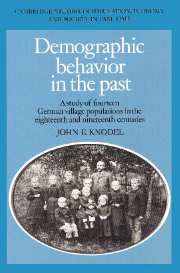 Demographic Behavior in the Past
Demographic Behavior in the Past Book contents
- Frontmatter
- Contents
- List of tables
- List of figures
- Acknowledgements
- PART I INTRODUCTION
- 1 Family reconstitution and the historical study of demographic behavior
- 2 The source and the sample
- PART II MORTALITY
- PART III FAMILY FORMATION
- PART IV MARITAL REPRODUCTION
- PART V INTERRELATIONSHIPS IN DEMOGRAPHIC BEHAVIOR
- PART VI CONCLUSION
- Appendices
- Bibliography
- Index
1 - Family reconstitution and the historical study of demographic behavior
Published online by Cambridge University Press: 04 August 2010
- Frontmatter
- Contents
- List of tables
- List of figures
- Acknowledgements
- PART I INTRODUCTION
- 1 Family reconstitution and the historical study of demographic behavior
- 2 The source and the sample
- PART II MORTALITY
- PART III FAMILY FORMATION
- PART IV MARITAL REPRODUCTION
- PART V INTERRELATIONSHIPS IN DEMOGRAPHIC BEHAVIOR
- PART VI CONCLUSION
- Appendices
- Bibliography
- Index
Summary
European historical demography was revolutionized in the 1950s by the pioneering analyses of Louis Henry using data assembled through the technique of family reconstitution. The technique involves a process through which individual records of births, deaths, and marriages (or baptisms, burials, and weddings) contained in parish registers are linked together into histories of vital events for individual families. The resultant micro-level set of linked information permits a far greater depth of analysis than is possible through earlier conventional approaches utilizing parish registers.
The earlier techniques relied primarily on simple aggregative counts of vital events. Thus the information available to the analyst was typically limited to annual or monthly time series of births, deaths, and marriages. These were used primarily to examine short-term fluctuations and their interrelationships. However, there was usually no basis to calculate demographic rates because, given the rarity and imperfections of census-like documents for much of the period covered by parish records, counts of the population at risk were generally unknown. Among other things, this seriously hampered longer-range comparisons. To put it simply, traditional aggregative counting techniques provided information on the flow of events but not the stock that gave rise to them.
The strengths of family reconstitution
Since family reconstitution establishes linkages between events happening to the same individual, or to members of the same family, far more demographic information is available for an individual or family than would otherwise be the case.
- Type
- Chapter
- Information
- Demographic Behavior in the PastA Study of Fourteen German Village Populations in the Eighteenth and Nineteenth Centuries, pp. 3 - 11Publisher: Cambridge University PressPrint publication year: 1988
- 1
- Cited by


